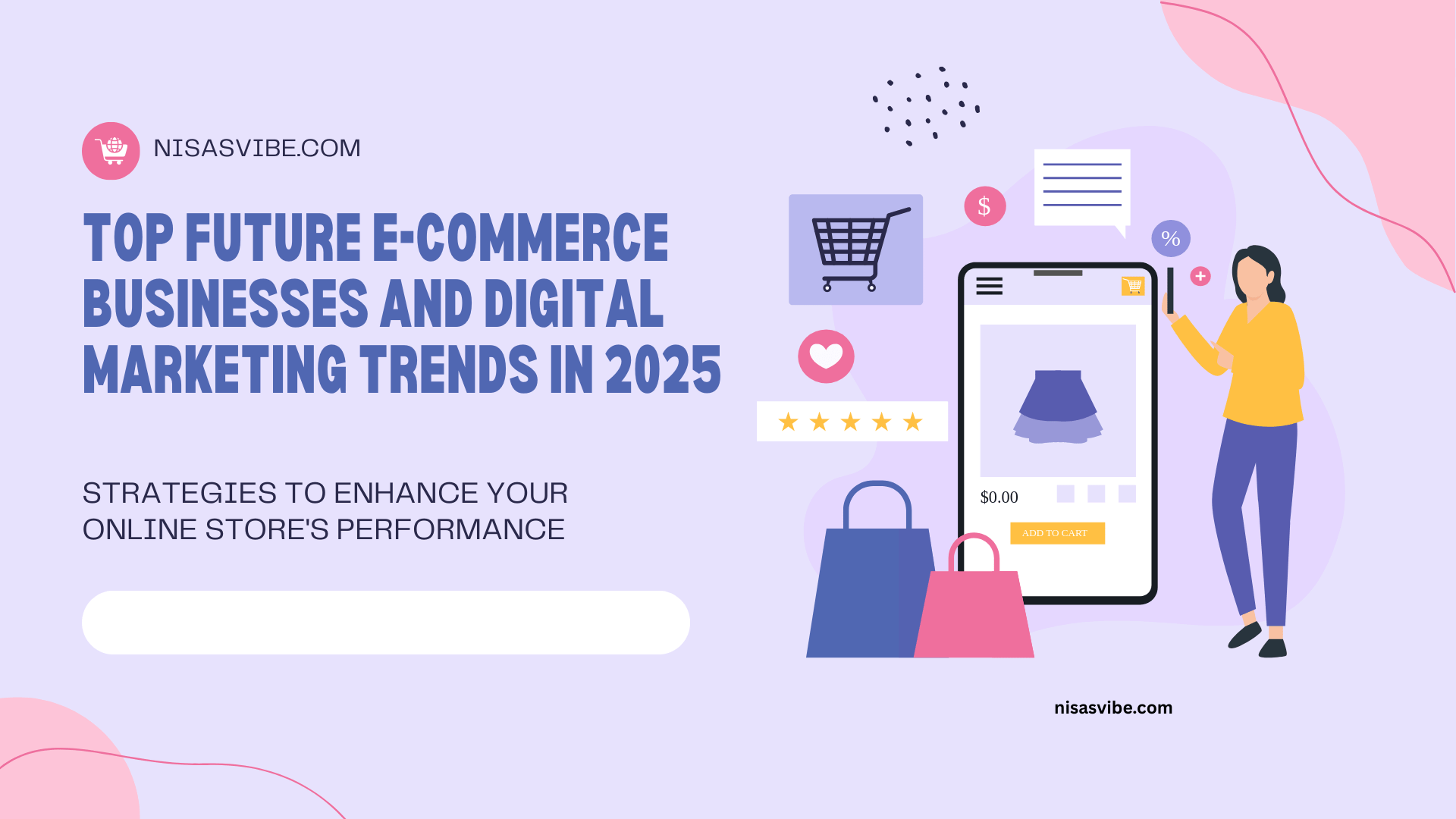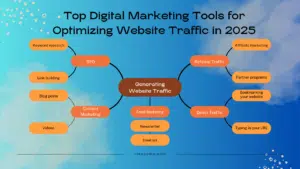Hi, I’m Nisa! As we look towards 2025, the e-commerce landscape is rapidly evolving. Digital marketing strategies will play an even bigger role in the success of e-commerce businesses. From cutting-edge technologies to changing consumer behaviors, businesses must adapt to these shifts to stay competitive. In this article, I’ll walk you through the top future e-commerce businesses and the digital marketing trends that will dominate in 2025.
1. AI and Automation in E-commerce
Artificial Intelligence (AI) and automation are transforming the way e-commerce businesses operate. These technologies are no longer a luxury but a necessity for staying competitive in 2025.
Why it matters:
- Personalized shopping experiences: AI helps e-commerce businesses deliver hyper-personalized experiences, suggesting products based on past behavior, preferences, and purchase history.
- Automated customer service: AI-powered chatbots and virtual assistants provide 24/7 support, improving customer satisfaction and reducing operational costs.
- Optimized inventory management: AI can forecast demand patterns, ensuring that businesses can manage stock levels more effectively and reduce waste.
How to leverage this trend:
- Implement AI-driven product recommendations: Use tools that personalize product suggestions for each user based on their browsing and buying behavior.
- Adopt AI-powered chatbots: Integrate chatbots on your website or mobile app to assist customers in real-time, improving customer service efficiency.
- Automate email marketing: Set up automated email campaigns triggered by user actions, such as cart abandonment or product recommendations.
2. Subscription-Based E-commerce Models
Subscription-based businesses are on the rise in 2025. From subscription boxes to software as a service (SaaS), customers are increasingly opting for recurring deliveries or access to products and services.
Why it matters:
- Predictable revenue: Subscription models provide a stable, recurring revenue stream, which is invaluable for e-commerce businesses.
- Customer retention: These models encourage ongoing relationships with customers, as they are committed to receiving regular shipments or services.
- Convenience and personalization: Subscriptions offer convenience by delivering curated products to customers’ doorsteps, often based on personalized preferences.
How to leverage this trend:
- Offer subscription boxes: Create a subscription service around your products, such as beauty boxes, food delivery, or curated lifestyle items.
- Build personalized subscriptions: Use data to offer personalized subscription services, such as customized clothing or tailored skincare kits.
- Create exclusive content or membership programs: Offer exclusive deals, early access to products, or members-only content for subscribers.
3. Social Commerce and Influencer Marketing
Social media platforms like Instagram, Facebook, and TikTok are not just for socializing anymore—they’re powerful e-commerce tools. Social commerce is the practice of selling products directly through social media platforms.
Why it matters:
- Direct sales through social media: Platforms like Instagram allow businesses to set up shop directly on their profiles, streamlining the purchasing process.
- Influencer-driven sales: Collaborating with influencers can significantly boost product visibility and lead to higher conversions, especially when paired with user-generated content.
- Consumer trust and engagement: Social media provides a more informal, engaging way to connect with your audience, building trust and fostering brand loyalty.
How to leverage this trend:
- Set up shop on social media: Utilize social commerce features on platforms like Instagram and Facebook to enable direct purchases.
- Work with micro-influencers: Collaborate with influencers who align with your brand to drive more targeted traffic and generate trust.
- Create engaging shoppable posts: Develop content that showcases your products in an authentic and relatable way, making it easy for followers to purchase.
4. Augmented Reality (AR) and Virtual Reality (VR)
Augmented Reality (AR) and Virtual Reality (VR) are becoming essential tools for e-commerce, particularly in industries like fashion, furniture, and beauty. These technologies allow customers to try before they buy in a virtual space.
Why it matters:
- Enhanced customer experience: AR and VR allow consumers to visualize products in their real-world environment, such as seeing how a sofa would look in their living room or testing makeup virtually.
- Increased conversions: By offering a more interactive and engaging shopping experience, AR and VR can help reduce returns and improve customer satisfaction.
- Innovative product experiences: These technologies offer a more immersive way to explore products, providing a unique edge over competitors.
How to leverage this trend:
- Integrate AR into your website: Allow customers to try on products virtually, such as clothing, eyewear, or makeup.
- Create VR shopping experiences: Use VR to create virtual stores or product demonstrations, providing a unique shopping experience.
- Develop interactive ads with AR: Create AR-based advertising campaigns where users can engage with your products through their smartphones.
5. Sustainability and Ethical E-commerce
In 2025, sustainability will be a driving force in consumer decision-making. E-commerce businesses that prioritize sustainability and ethical practices will have a competitive advantage.
Why it matters:
- Consumer demand for eco-friendly products: More consumers are becoming aware of environmental issues and are choosing brands that prioritize sustainability.
- Brand loyalty: Businesses that align with customers’ values around sustainability and ethical production will build deeper relationships with their audience.
- Regulations: Governments are increasingly implementing regulations around packaging, waste, and carbon emissions, making sustainability a key business consideration.
How to leverage this trend:
- Offer eco-friendly products: Introduce sustainable products or eco-friendly packaging options to appeal to environmentally conscious customers.
- Promote ethical practices: Highlight your brand’s commitment to fair labor practices, reducing waste, and supporting local communities in your marketing efforts.
- Offset carbon emissions: Implement carbon offset programs to reduce your business’s environmental impact and appeal to eco-conscious consumers.
6. Voice Search and Conversational Commerce
Voice search is on the rise, thanks to devices like Amazon Alexa, Google Assistant, and Siri. In 2025, voice search will become an increasingly important part of the shopping experience, particularly in the mobile and home assistant markets.
Why it matters:
- Increased voice shopping: As more consumers use voice assistants to search for products and make purchases, businesses must optimize for voice search.
- Conversational commerce: This form of commerce allows customers to make purchases through voice interactions, chatbots, or messaging apps, making shopping more seamless.
- Hands-free convenience: Voice search provides a hands-free, convenient way for customers to shop on the go, increasing accessibility.
How to leverage this trend:
- Optimize for voice search: Use long-tail, conversational keywords that mirror how people speak when making voice queries.
- Enable voice-activated shopping: Offer voice-based shopping features on your website or app, allowing users to search for and purchase products using voice commands.
- Integrate chatbots and messaging apps: Use AI-driven chatbots to facilitate voice-based interactions and transactions through apps like WhatsApp or Facebook Messenger.
7. Data Privacy and Consumer Trust
As data breaches and privacy concerns continue to grow, consumers will prioritize businesses that respect their privacy and protect their personal information. In 2025, data privacy will be a major focus for e-commerce businesses.
Why it matters:
- Building trust: Transparency around data collection and usage will help businesses build stronger relationships with their customers.
- Compliance with regulations: Adhering to data privacy laws like GDPR and CCPA will be essential to avoid penalties and maintain customer trust.
- Security and privacy concerns: E-commerce businesses need to ensure their websites are secure and that customer data is protected from breaches and misuse.
How to leverage this trend:
- Implement strong data protection measures: Use encryption, secure payment gateways, and robust cybersecurity practices to safeguard customer data.
- Be transparent about data usage: Clearly communicate how you collect, store, and use customer data, and provide easy opt-out options.
- Stay compliant: Keep up with data privacy regulations to ensure your business adheres to legal standards and builds trust with your customers.

Future-Proofing Your E-commerce Strategy
The e-commerce industry in 2025 will be shaped by innovation, sustainability, and technology. From AI-driven personalization to voice search optimization, businesses that embrace these trends will have a competitive edge. By adapting your digital marketing strategies to align with emerging technologies, you can ensure your e-commerce business thrives in the future.
Focus on delivering personalized experiences, building trust with your audience, and staying ahead of technological advancements to future-proof your business for the years to come.




